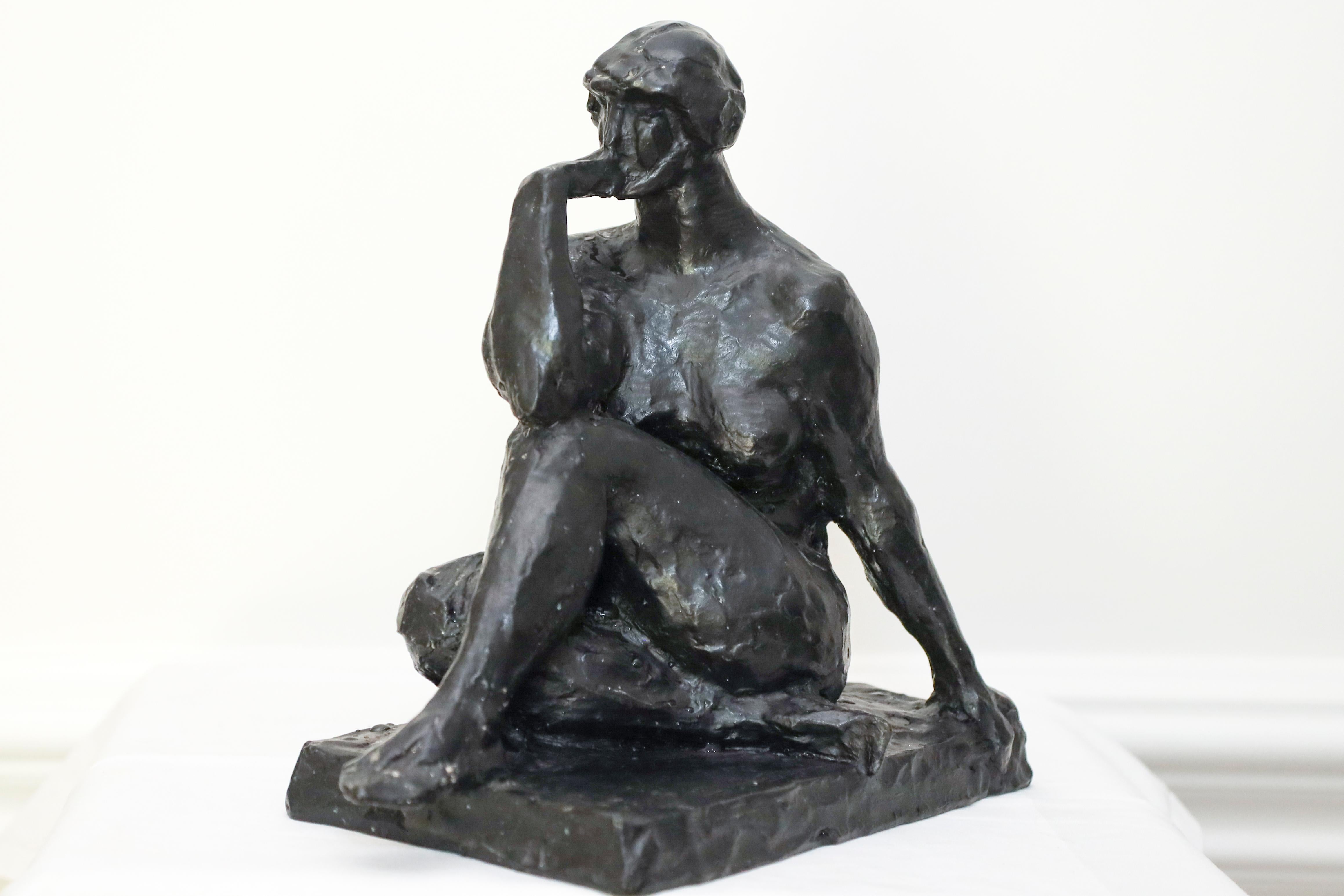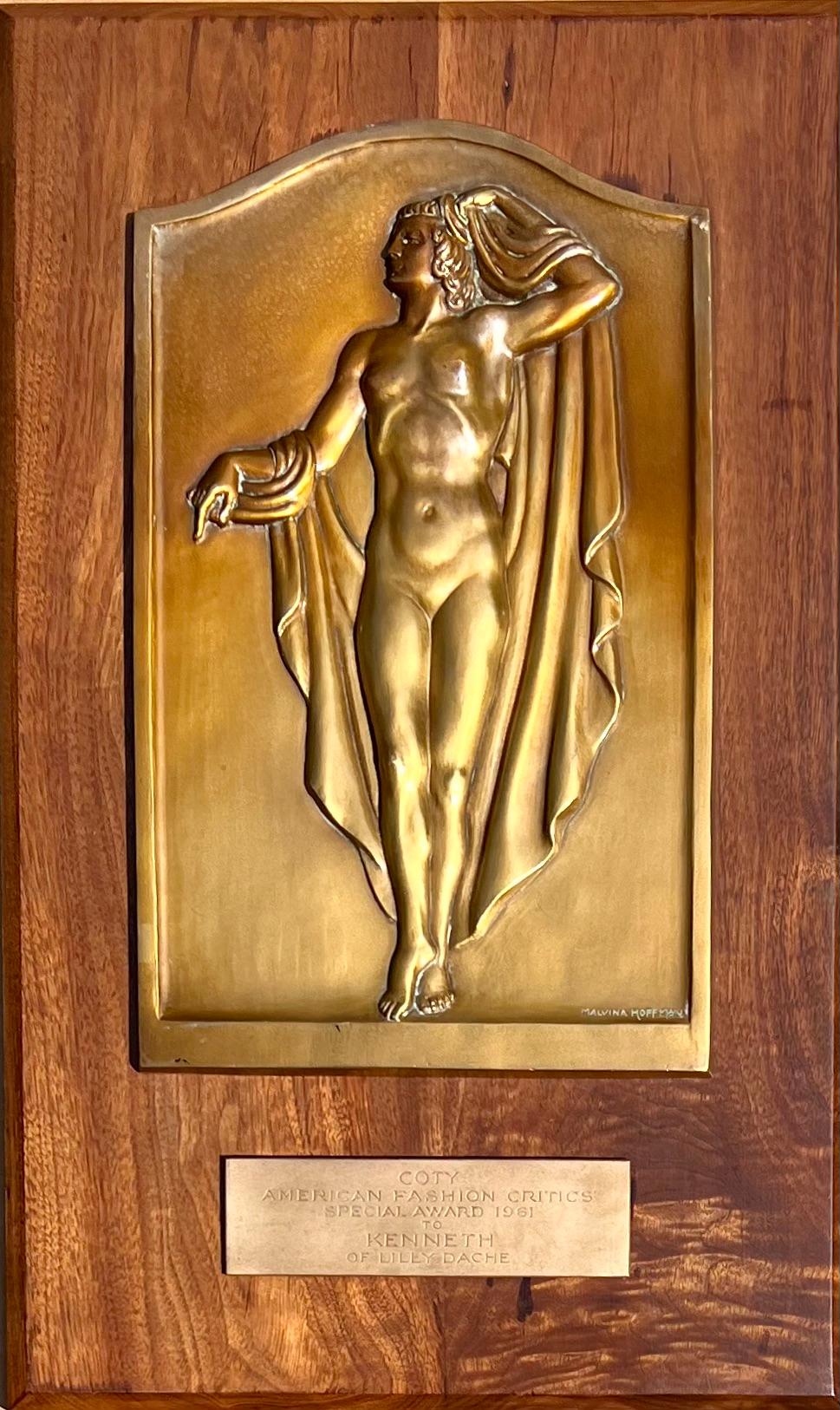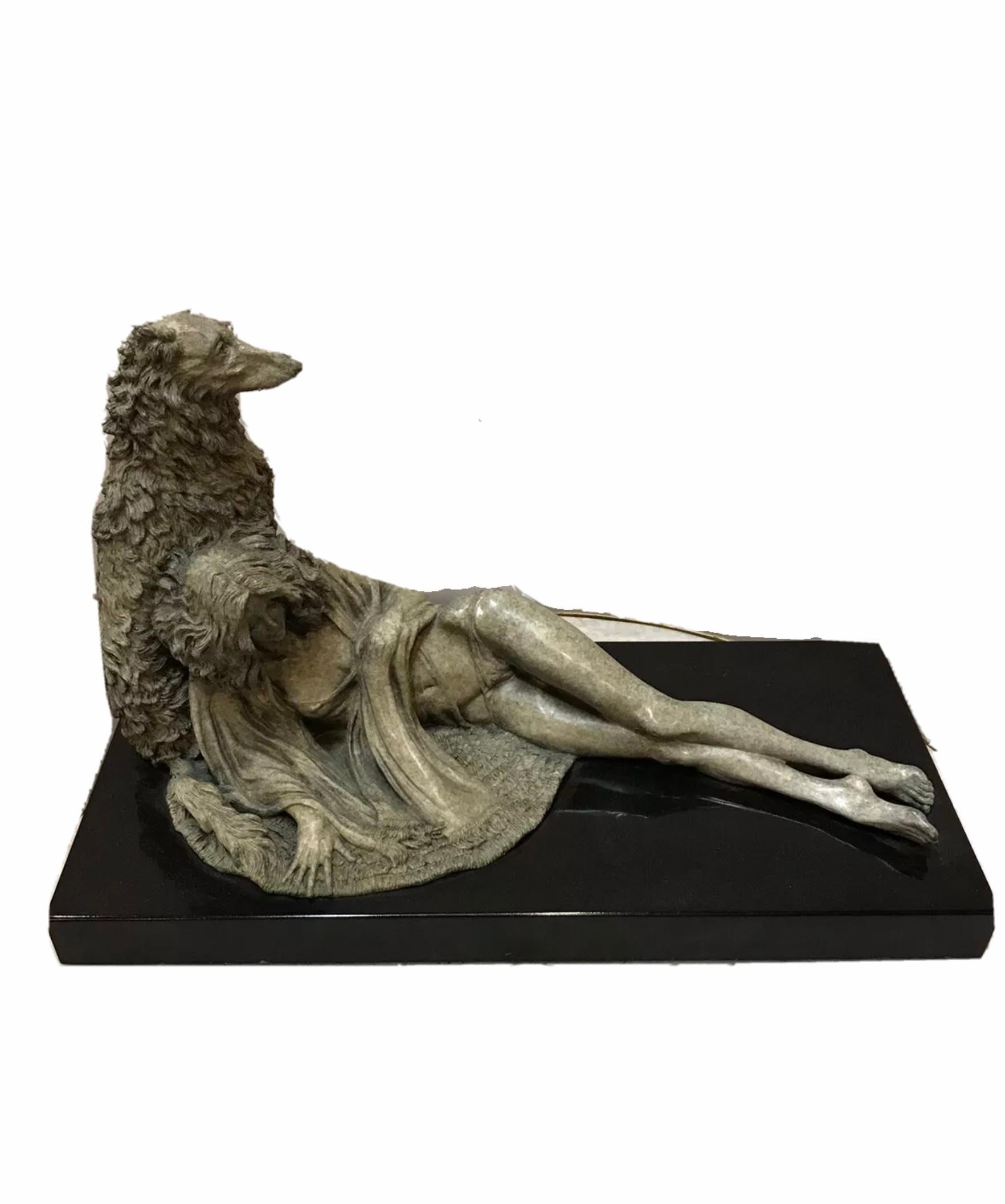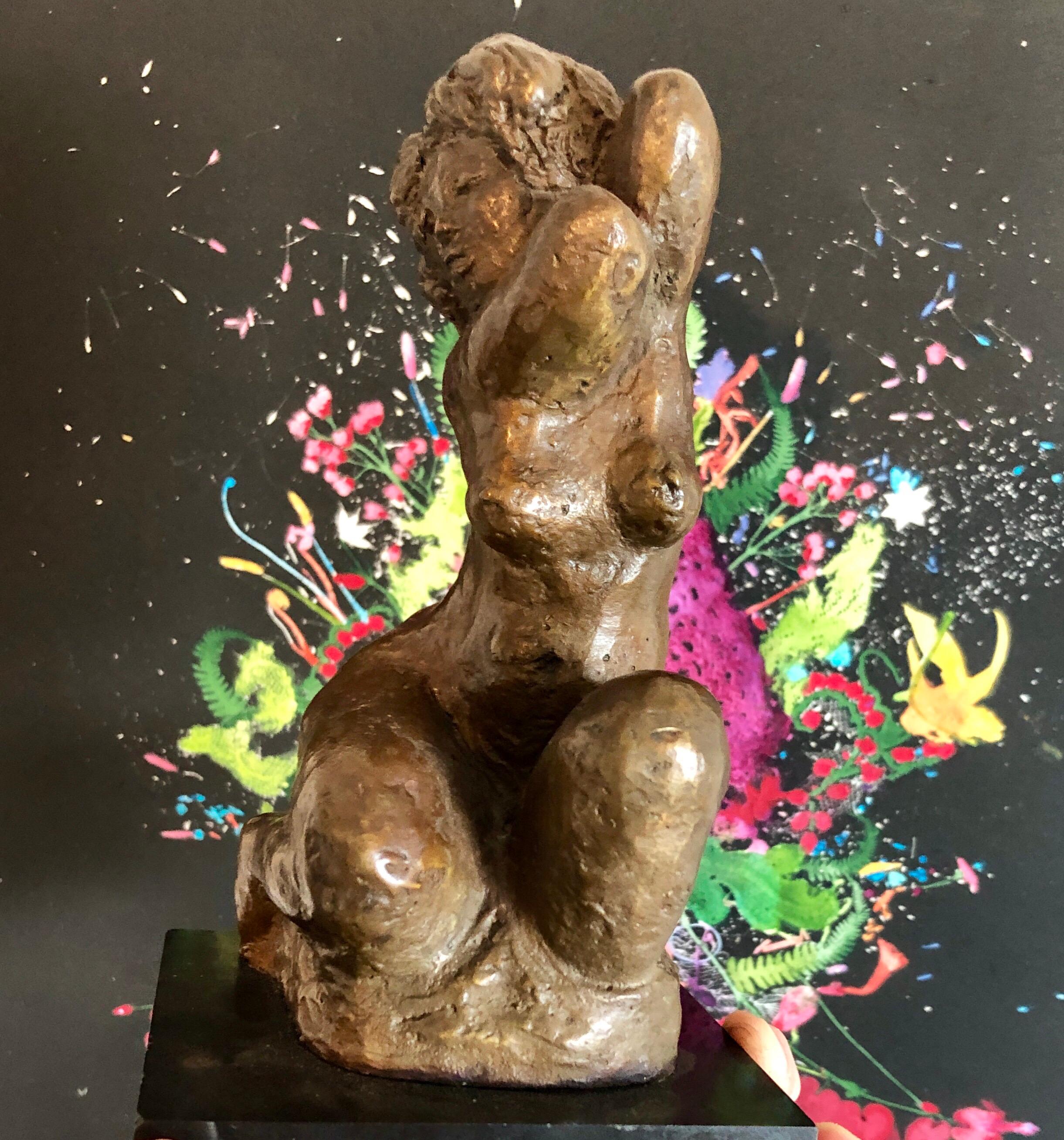Items Similar to Nude Walking, Early 20th Century Bronze Sculpture, Cleveland School Artist
Want more images or videos?
Request additional images or videos from the seller
1 of 11
Max KalishNude Walking, Early 20th Century Bronze Sculpture, Cleveland School Artist1930
1930
About the Item
Max Kalish (American, 1891-1945)
Nude Walking, 1930
Bronze
Signed and dated on base
17 x 9 x 4 inches
Born in Poland March 1, 1891, figurative sculptor Max Kalish came to the United States in 1894, his family settling in Ohio. A talented youth, Kalish enrolled at the Cleveland Institute of Art as a fifteen-year-old, receiving a first-place award for modeling the figure during studies with Herman Matzen. Kalish went to New York City following graduation, studying with Isidore Konti and Herbert Adams for the next two years.
In 1912, Kalish studied with Paul Bartlett at the Academie Colarossi in Paris, France. In 1913, he continued his studies with Jean Antoine Injalbert at the Ecole des Beaux-Arts. The financial support of his brother, family and friends had enabled Kalish to travel to Europe. But the money ran out and, though Kalish exhibited two portrait busts in the 1913 Paris Salon, he was forced to return to America, where he worked on the Column of Progress for the 1915 Panama-Pacific Exposition, in San Francisco, California, with his former teacher, Isidore Konti.
Back in Cleveland, he worked on portrait commissions of two United States Senators and the Mayor. In the Army by 1916, Kalish sculpted a series of bronze, one-third-life-size figures of solders. In 1920, he was back in Paris, where he would begin a life-long practice of spending half the year. In 1921, he sculpted his first laborer, “The Stoker”, a genre for which he would be best known, using as a model, a Cleveland blast furnace worker. In Paris in 1922, the sculptures of laborers by Belgian artist Constantine Meunier (1831-1905) cemented Kalish’s desire to sculpt workers. Kalish won first prize for four sculptures three laborers — in 1925 at the Cleveland Artists and Craftsmen exhibition, one of which a marble nude torso was acquired by the Cleveland Museum of Art. This prize and purchase accelerated Kalish’s career. In 1928, he received a commission from the City of Cleveland for a twelve-foot-high bronze sculpture of Abraham Lincoln delivering the Gettysburg Address. It stands today in front of the west entrance of the Board of Education on East 6th Street.
Living and working in New York City in 1932, he was elected an Associate of the National Academy of Design in 1933. He later became a member of the National Sculpture Society. At the outset of World War II, Kalish was commissioned by the Museum of American History to sculpt forty-eight bronze figures — one-third-life-size — of those involved in the war effort, including President Roosevelt, his cabinet and other important people. He lived to see the work completed, though afflicted by cancer from which he died on March 18, 1945 in New York City. The sculpture of Max Kalish was included in the 1997 exhibition in Berkeley, California, “When Artists Became Workers: The People’s Art Movement of the ’30s and ’40s”, at the Judah L. Magnes Museum.
Books about the life and work of Max Kalish include Lawson Lewis’s 1933, The Sculpture of Max Kalish; the 1938 publication, Labor Sculpture by Max Kalish; James Mackay’s, 1977, Dictionary of Sculptors in Bronze; Glenn Opitz’s, 1984, Dictionary of American Sculptors; and Rediscoveries in American Sculpture by Janis Conner & Joel Rosenkranz, 1989.
- Creator:Max Kalish (1891 - 1945, American, Lithuanian)
- Creation Year:1930
- Dimensions:Height: 17 in (43.18 cm)Width: 9 in (22.86 cm)Depth: 4 in (10.16 cm)
- Medium:
- Movement & Style:
- Period:
- Condition:
- Gallery Location:Beachwood, OH
- Reference Number:1stDibs: LU1768213721392
About the Seller
No Reviews Yet
Vetted Seller
These experienced sellers undergo a comprehensive evaluation by our team of in-house experts.
Established in 1975
1stDibs seller since 2022
9 sales on 1stDibs
Typical response time: 19 hours
- ShippingRetrieving quote...Ships From: Beachwood, OH
- Return PolicyA return for this item may be initiated within 14 days of delivery.
More From This SellerView All
- Harmony, 20th century bronze & green marble base, nude man and woman with lyreBy Max KalishLocated in Beachwood, OHMax Kalish (American, 1891-1945) Harmony, c. 1930 Bronze with green marble base Incised signature on right upper side of base 14 x 9 x 5 inches, excluding base 17 x 10 x 8 inches, including base Born in Poland March 1, 1891, figurative sculptor Max Kalish came to the United States in 1894, his family settling in Ohio. A talented youth, Kalish enrolled at the Cleveland Institute of Art as a fifteen-year-old, receiving a first-place award for modeling the figure during studies with Herman Matzen. Kalish went to New York City following graduation, studying with Isidore Konti...Category
1930s American Modern Figurative Sculptures
MaterialsMarble, Bronze
- 19th Century Bronze Figure of Crouching Venus or Naked AphroditeLocated in Beachwood, OH19th Century Bronze Figure of Crouching Venus or Naked Aphrodite Bronze with dark patination 22.5 x 13 x 11 inches The Crouching Venus is a Hellenisti...Category
19th Century Figurative Sculptures
MaterialsBronze
- Le Challenge de Gramont, 20th Century bronze sculpture of IcarusLocated in Beachwood, OHLouise Ochsé (Belgian, 1884-1944) Le Challenge de Gramont, 1925 Bronze Signed and dated on base 21 x 12 x 9 inches Louise Ochsé was a Franco-Belgian sculptor. Born in Brussels, Belg...Category
1920s Figurative Sculptures
MaterialsBronze
- Pan of Rohallion, 1889-90 classical bronze sculptureBy Frederick William MacMonniesLocated in Beachwood, OHFrederick W. MacMonnies (American, 1863-1937) Pan of Rohallion, 1889-90 (Garden 22) Bronze Signed on base, 'ROMAN BRONZE WORKS NY' at base 14.25 x 4 x 6 inches A sculptor of classical figures, American-born Frederick MacMonnies...Category
1880s Figurative Sculptures
MaterialsBronze
- Diana the Huntress, 1890 classical bronze sculptureBy Frederick William MacMonniesLocated in Beachwood, OHFrederick William MacMonnies (American, 1863-1937) Diana, 1890 Bronze with green verdigris patina Signed and dated Copyright 1894 with Jaboeuf & Rouard, Paris foundry mark 31 x 21 x 17 inches A sculptor of classical figures, American-born Frederick MacMonnies...Category
1890s Figurative Sculptures
MaterialsBronze
- Nude Female Torso Bronze Sculpture, 20th Century Contemporary American ArtistLocated in Beachwood, OHAlan Cottrill (American, Ohio, b. 1952) Nude Female Torso, 1994 Bronze mounted to green marble base Signed, dated and numbered 14/20 verso of leg, with foundry stamp 17. in. h. x 6 i...Category
1990s Figurative Sculptures
MaterialsMarble, Bronze
You May Also Like
- Woman Seated A Bronze Sculpture of a Woman by Charles RumseyBy Charles Cary RumseyLocated in Brookville, NYThe bronze sculpture of a woman by Charles Rumsey is undated, but was created at a point in his career where he began to transition from realism to more modern, looser depictions of ...Category
1920s American Modern Figurative Sculptures
MaterialsBronze
- 1961 Coty Award Plaque Kenneth Hairdresser Jacqueline Onassis Bronze FashionLocated in New York, NY1961 Coty Award Plaque Kenneth Hairdresser Jacqueline Onassis Bronze Fashion Bronze on wood. The wood plaque measures 12 3/4" by 20 3/4 inches. The bronze plaque itself is 13 3/4 x 8 3/4 inches and the the bronze inscription, which reads "COTY, American Fashion Critics Special Award 1961 to KENNETH of LILY DACHE...Category
1960s American Modern Figurative Sculptures
MaterialsBronze
- LADY AND SCOTTISH DOGLocated in Pasadena, CAMagnificent beautiful masterpiece bronze sculpture of lady with the Scottish Deer Hunter dog bronze comes with green patina; 1/10 So beautiful and a lot...Category
2010s American Modern Figurative Sculptures
MaterialsBronze
- Bronze Female Nude Sculpture Modernist, WPA, New York Chelsea Hotel ArtistBy Eugenie GershoyLocated in Surfside, FLEugenie Gershoy (January 1, 1901 – May 8, 1986) was an American sculptor and watercolorist. Eugenie Gershoy was born in Krivoy Rog, Russia (Krivoi Rog, Ukraine) and emigrated to New York City in the United States as a child in 1903. Considered somewhat of a child prodigy, Gershoy was copying Old Master drawings at the age of 5. Her interest and talent in art was encouraged from a very young age. Aided by scholarships, she studied at the Art Students League under Alexander Stirling Calder, Leo Lentelli, Kenneth Hayes Miller, and Boardman Robinson. Around this time, she created a group of portrait figurines of her fellow artists, including Arnold Blanch, Lucile Blanch, Raphael Soyer, William Zorach, Concetta Scaravaglione, and Emil Ganso, which were exhibited as a group at the Whitney Museum of American Art. At age 17, she was awarded the Saint-Gaudens Medal for fine draughtsmanship. Early in her career she became an active member of the Woodstock art colony. In Woodstock she experimented by sculpting in the profusion of indigenous materials that she found. Working with fieldstone, oak and chestnut, Gershoy created works based on classic formulae. As she became more interested in the dynamism of everyday life, she found that these materials and her idiom were too restrictive. By the time Gershoy came to Woodstock in 1921 her own individual artistic style was already evident in her sculptures. Eugenie Gershoy worked in stone, bronze, terracotta, plaster and papier-mache. Gershoy’s sculptures were mainly figurative in nature and many of her artist peers such as Carl Walters, Raphael and Moses Soyer, William Zorach and Lucille Blanch, became her subjects. Eugenie Gershoy’s works on paper should not be overlooked. She was the winner of the Gaudens Medal for Fine Draughtsmanship at the tender age of 17. Gershoy married Jewish Romanian-born artist Harry Gottlieb. In the late 1920s and early 1930s, the pair kept a studio in Woodstock, New York. There, Gershoy was influenced by sculptor John Flanagan, who lived and worked nearby. From 1936 to 1939, Gershoy worked for the WPA Federal Art Project. She collaborated with Max Spivak on murals for the children's recreation room of the Queens Borough Public Library in Astoria, New York. She developed a mixture of wheat paste, plaster, and egg tempera, which she used in polychrome papier-mâché sculptures; she was the only New York sculptor to work in polychrome at this time. She also designed cement and mosaic sculptures of animals and figures to be placed in New York City playgrounds. Alongside others employed by the FAP, she participated in a sit-down strike in Washington, DC, to advocate for better pay and improved working conditions for the projects' artists. Gershoy's first solo exhibition was held at the Robinson Gallery in New York in 1940. She moved to San Francisco in 1942, and began teaching ceramics at the California School of Fine Arts in 1946. In 1950, she studied at the artists' colony at Yaddo. Gershoy traveled extensively throughout her life. She visited England and France in the early 1930s, and worked in Paris in 1951. She traveled to Mexico and Guatemala in the late 1940s, and also toured Africa, India, and the Orient in 1955. In 1977, Gershoy dedicated a sculpture to Audrey McMahon, who was actively involved in the creation of the Federal Art Project and served as its regional director in New York, in recognition of the work McMahon provided struggling artists in the 1930s. Gershoy's work is in the collections of the Whitney Museum of American Art, the Metropolitan Museum of Art, and the Smithsonian American Art Museum. Her papers are held at Syracuse University Grant Arnold introduced her to lithography in 1930 and Gershoy depicted many scenes of Woodstock artists and their daily activities through this medium. From 1942 to 1966 Gershoy lived and painted in San Francisco where she taught at the San Francisco Art Institute. She traveled extensively, filling sketchbooks with scenes of Mexico, France, Spain, Africa and India. During her later years Eugenie Gershoy returned to New York City and concentrated on numerous well received exhibitions. Her last exhibition in at Sid Deutsch Gallery included many of the sculptures that were later exhibited in the Fletcher Gallery. John Russell, former chief critic of fine arts for the New York Times, writes about the 1986 Sid Deutsch exhibition: “As Eugenie Gershoy won the Saint-Gaudens Medal for fine draftsmanship as long ago as 1914 and since 1967 has had 15 papier-mache portrait figures suspended from the ceiling of the lobby of the Hotel Chelsea, she must be ranked as a veteran of the New York scene. Her present exhibition includes not only the high-spirited papier-mache sculptures for which she is best known but a group of small portraits of artists, mostly dating from the 30’s, that is strongly evocative.” Eugenie Gershoy is an artist to take note of for several reasons. She was a woman who received great awards and recognition during a time when most female artists were struggling to hold their own against their male counterparts. As a young girl she won a scholarship to the Arts Student League where she met Hannah Small...Category
Mid-20th Century American Modern Nude Sculptures
MaterialsBronze
- Three DancersLocated in Santa Fe, NM"A beautiful work, full of Hebald's lyrical expression." To my knowledge, as the representative for the life works of Milton Hebald, (and through extensive research over the past 20...Category
Mid-20th Century American Modern Figurative Sculptures
MaterialsBronze
- Reclining BoyBy Dudley Vaill TalcottLocated in Boston, MAInitialed and dated: "DVT 61". From the estate of the artist. In fine condition.Category
Mid-20th Century American Modern Figurative Sculptures
MaterialsBronze





